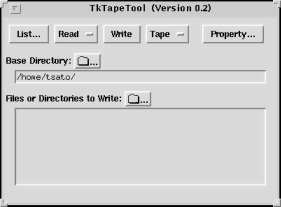[ Home
> TkDeskSet
> TkTapeTool ]
TkTapeTool - simple front-end for GNU tar
 TkTapeTool is a simple front-end for
GNU tar,
which provides facility to backup to/restore from magnetic tapes
in the similar manner with Tape Tool of
OpenWindowsTM's DeskSetTM.
TkTapeTool is a simple front-end for
GNU tar,
which provides facility to backup to/restore from magnetic tapes
in the similar manner with Tape Tool of
OpenWindowsTM's DeskSetTM.
There are number of more sophisticated backup tools,
but simple tool like this may be useful in some cases.
[ Download ]
Facilities
Main Window
- "List..." button
- Read list of files in the archive,
and display the list on a separate window.
It is possible to read specified files from the archive,
by choosing "Read Selected Files"
after selecting one ore more files on the list.
- "Read" menu
- This menu contains following items.
- "Read Selected Files"
- Read files selected on the list (which can be displayed by "List...")
from the archive.
Directory specified with "Base Directory" will be used
as base for filenames in relative path.
- "Read Entire Tape"
- Read all files from the archive.
Directory specified with "Base Directory" will be used
as base for filenames in relative path.
- "Write" button
- Write files or directories specified with "Files or Directories to Write"
to the archive.
Directory specified with "Base Directory" will be used
as base for filenames in relative path.
If head of filenames in absolute path matches "Base Directory",
the matched component will be removed.
- "Tape" menu
- This menu usally contains "Offline", "Rewind" and "Retention".
If floppy disk is selected as the device for backup,
this menu will contains "Format Floppy" instead.
- "Property..." button
- Open Property panel
to specify device for backup and some parameters.
- "Base Directory"
- Specify the directory which will be used as base for relative filenames.
- "Files or Directories to Write"
- Specify files or directories to be written to the archive.
Directory specified with "Base Directory" will be used
as base for filenames in relative path.
- "Device" menu
- Select device to store backup.
This menu contains devices which correspond to tapes or floppies
(/dev/st0, /dev/rmt/0, /dev/fd0, etc.)
and accessible by the user.
Selecting "Other" here will allow users to specify any device name or filename.
Selecting "Remote..." here will popup panel to specify
host, user name and device name of the remote machine.
- "Close" button
- Close the Property panel.
- "Save Settings" button
- Save current settings on the Property panel to
.tktapetoolrc file in the home directory.
This will be used as the initial setting when this program is invoked next.
- "Set to Default Settings" button
- Set settings on the Property panel to the default value.
- Options
-
- "Don't overwrite existing files when extracting"
- Don't read files from the archive
if file of the same filename already exists.
- "Remove old file prior to extracting over it"
- Remove file prior to read it
if file of the same filename already exists.
This option may be required when file of same filename already exists
and the file is write protected.
- "Ignore blocks of zeros in archive"
- Read entire archive even if the archive contains block of zeros
between file entries.
This usally indicates the end of the archive,
and this program will normally stop reading at the point.
This option may be required when reading damaged archive
or archive created by concatenating several archives together.
- "Extract all protection information"
- Set the mode (access permission) of extracted files exactly
as recorded in the archive.
- "Format"
- Set format of the archive to be created.
Available formats are: standard GNU tar format,
POSIX comformant format, and old V7 format.
- "Dereference symbolic-links"
- If file to be backed up is a symbolic link,
backup the file that the symbolic link points to.
- "Don't backup files in the other file system"
- Don't backup files that are on different file systems
from the current directory.
- "Compress"
- Specify if archive is compressed or not.
For compression, compress or gzip can be used.
- "Multi-volume archive"
- If archive can't stored in a single medium,
split it to multiple media.
This option may cause error when format other than GNU tar format is selected
or compression is selected.
- "Display file list when processing"
- Display list of files when writing or reading archive.
 by T.Sato, 2000/3/19
by T.Sato, 2000/3/19
 TkTapeTool is a simple front-end for
GNU tar,
which provides facility to backup to/restore from magnetic tapes
in the similar manner with Tape Tool of
OpenWindowsTM's DeskSetTM.
TkTapeTool is a simple front-end for
GNU tar,
which provides facility to backup to/restore from magnetic tapes
in the similar manner with Tape Tool of
OpenWindowsTM's DeskSetTM.
 by T.Sato, 2000/3/19
by T.Sato, 2000/3/19